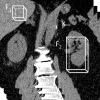Adrenal gland abnormality detection using random forest classification
- PMID: 23344259
- PMCID: PMC3782594
- DOI: 10.1007/s10278-012-9554-7
Adrenal gland abnormality detection using random forest classification
Abstract
Adrenal abnormalities are commonly identified on computed tomography (CT) and are seen in at least 5 % of CT examinations of the thorax and abdomen. Previous studies have suggested that evaluation of Hounsfield units within a region of interest or a histogram analysis of a region of interest can be used to determine the likelihood that an adrenal gland is abnormal. However, the selection of a region of interest can be arbitrary and operator dependent. We hypothesize that segmenting the entire adrenal gland automatically without any human intervention and then performing a histogram analysis can accurately detect adrenal abnormality. We use the random forest classification framework to automatically perform a pixel-wise classification of an entire CT volume (abdomen and pelvis) into three classes namely right adrenal, left adrenal, and background. Once we obtain this classification, we perform histogram analysis to detect adrenal abnormality. The combination of these methods resulted in a sensitivity and specificity of 80 and 90 %, respectively, when analyzing 20 adrenal glands seen on volumetric CT datasets for abnormality.
Figures






Similar articles
-
Histogram analysis for characterization of indeterminate adrenal nodules on noncontrast CT.Abdom Imaging. 2015 Aug;40(6):1666-74. doi: 10.1007/s00261-014-0307-6. Abdom Imaging. 2015. PMID: 25488345
-
Linear and volumetric evaluation of the adrenal gland--MDCT-based measurements of the adrenals.Acad Radiol. 2014 Nov;21(11):1465-74. doi: 10.1016/j.acra.2014.06.008. Acad Radiol. 2014. PMID: 25300724
-
C-arm cone-beam computed tomography with stereotactic needle guidance for percutaneous adrenal biopsy: initial experience.Acta Radiol. 2017 May;58(5):617-624. doi: 10.1177/0284185116661882. Epub 2016 Sep 30. Acta Radiol. 2017. PMID: 27552980
-
Calcified Adrenal Lesions: Pattern Recognition Approach on Computed Tomography With Pathologic Correlation.J Comput Assist Tomogr. 2020 Mar/Apr;44(2):178-187. doi: 10.1097/RCT.0000000000000980. J Comput Assist Tomogr. 2020. PMID: 32195796 Review.
-
[Cone Beam computerized tomography and implants].Rev Stomatol Chir Maxillofac. 2012 Sep;113(4):245-58. doi: 10.1016/j.stomax.2012.05.009. Epub 2012 Aug 11. Rev Stomatol Chir Maxillofac. 2012. PMID: 22889565 Review. French.
Cited by
-
Adrenal lesion classification with abdomen caps and the effect of ROI size.Phys Eng Sci Med. 2023 Jun;46(2):865-875. doi: 10.1007/s13246-023-01259-y. Epub 2023 Apr 25. Phys Eng Sci Med. 2023. PMID: 37097380
-
A combined encoder-transformer-decoder network for volumetric segmentation of adrenal tumors.Biomed Eng Online. 2023 Nov 8;22(1):106. doi: 10.1186/s12938-023-01160-5. Biomed Eng Online. 2023. PMID: 37940921 Free PMC article.
-
Characterization of adrenal glands on computed tomography with a 3D V-Net-based model.Insights Imaging. 2025 Jan 14;16(1):17. doi: 10.1186/s13244-025-01898-7. Insights Imaging. 2025. PMID: 39808346 Free PMC article.
-
A Random Forest classifier-based approach in the detection of abnormalities in the retina.Med Biol Eng Comput. 2019 Jan;57(1):193-203. doi: 10.1007/s11517-018-1878-0. Epub 2018 Aug 4. Med Biol Eng Comput. 2019. PMID: 30076537
-
An extensive study for binary characterisation of adrenal tumours.Med Biol Eng Comput. 2019 Apr;57(4):849-862. doi: 10.1007/s11517-018-1923-z. Epub 2018 Nov 14. Med Biol Eng Comput. 2019. PMID: 30430422
References
-
- Mayo-Smith WW, Boland GW, Noto RB, Lee MJ. State-of-the-art adrenal imaging. Radiographics. 2001;21(4):995–1012. - PubMed
-
- Peña CS, Boland GW, Hahn PF, Lee MJ, Mueller PR. Characterization of indeterminate (lipid-poor) adrenal masses: use of washout characteristics at contrast-enhanced CT. Radiology. 2000;211(3):629–636. - PubMed
-
- “Radiology Associates.” [Online]. Available: http://www.rasloimaging.com/for_physcians/Master Schedules/Newsletters/Feb.2012 Newsletter.pdf. Accessed 10 May 2012.
-
- Yao C, Wada T, Shimizu A, Kobatake H, Nawano S. Simultaneous location detection of multi-organ by atlas-guided eigen-organ method in volumetric medical images. Int J CARS. 2006;1:42–44.
MeSH terms
LinkOut - more resources
Full Text Sources
Other Literature Sources

